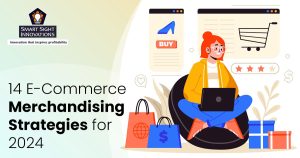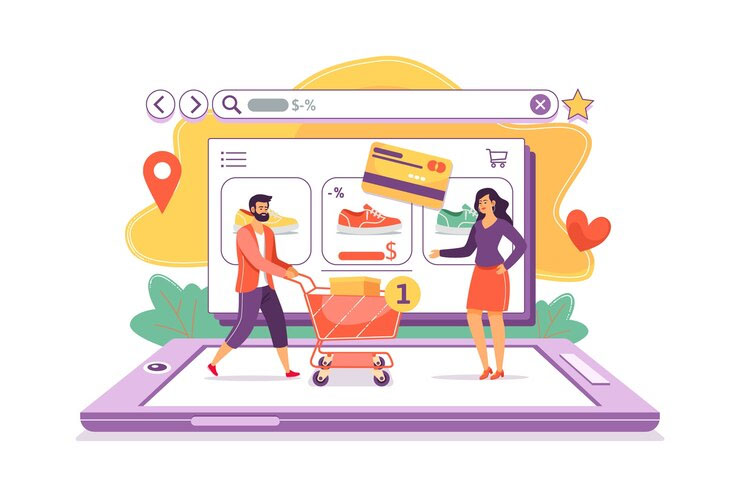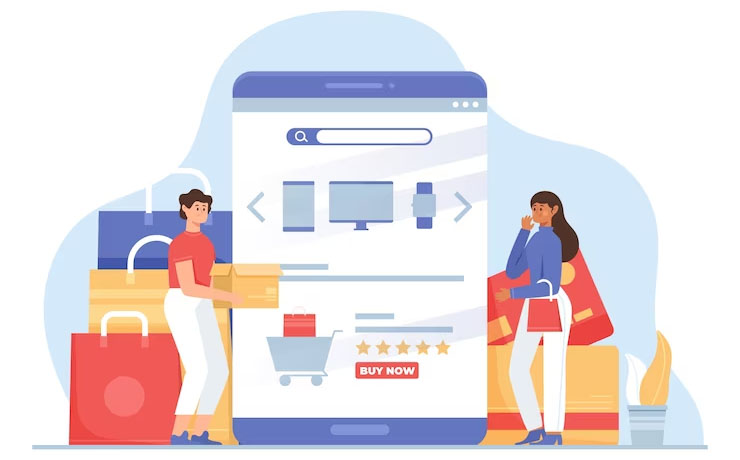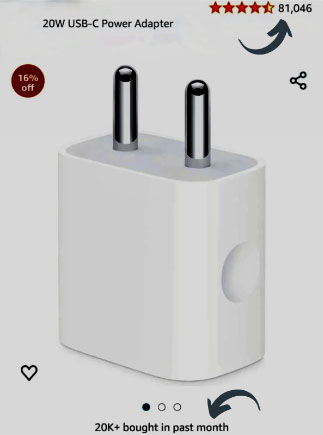 Early online stores resembled digital catalogs, with basic product listings and rudimentary search functions. Merchandising focused primarily on product categorization and sorting.
Early online stores resembled digital catalogs, with basic product listings and rudimentary search functions. Merchandising focused primarily on product categorization and sorting.
They experimented with banner ads and email marketing, but the emphasis remained on displaying available products rather than tailoring them to specific customer needs.
The way we shop online has undergone a dramatic transformation in recent years. Gone are the days of static web pages and limited product information. Today’s e-commerce landscape demands a dynamic, data-driven approach to product presentation, known as merchandising.
As technology and competition advance, so has the need for a more sophisticated approach. Merchandising strategies have begun to incorporate data insights, such as understanding customer behavior and personalizing product recommendations through the use of website analytics.
This article explains why merchandising is a vital area of focus for e-commerce and lists down some of the most popular strategies businesses can use to stay ahead of their competition.
Understanding the Importance of Effective Merchandising in 2024
In the world of e-commerce, effective merchandising plays a pivotal role in capturing the attention and loyalty of consumers. As we step into 2024, several factors highlight the crucial importance of strategic merchandising for online retailers.
1. Changing Consumer Preferences
Consumer preferences are in constant flux, influenced by trends, technology, and societal shifts. Effective merchandising is essential to staying attuned to these changes.
By analyzing and adapting to the evolving preferences of the target audience, e-commerce businesses can ensure that their product offerings align with what customers desire.
2. Fierce Competition in the Digital Space
The e-commerce landscape is highly competitive, with numerous businesses vying for the attention of online shoppers. In such a scenario, standing out becomes a challenge.
Effective merchandising not only showcases products but creates an immersive brand experience that resonates with consumers, setting a brand apart from the competition.
3. The Rise of Personalization
As consumers expect personalized experiences, generic or one-size-fits-all approaches are no longer sufficient. Effective merchandising involves leveraging data and technology to tailor the shopping experience for individual users.
Personalized product recommendations, targeted promotions, and tailored content contribute to higher customer satisfaction and increased conversion rates.
4. Mobile Commerce Dominance
The increasing prevalence of smartphones has made mobile commerce a dominant force. Merchandising strategies must prioritize mobile-friendly designs and seamless user experiences.
The ability to effortlessly navigate and make purchases on mobile devices is critical for attracting and retaining customers.
E-Commerce Merchandising Strategies
One factor that distinguishes e-commerce companies from traditional retail establishments is that they lack an attractive storefront to draw customers. Therefore, to establish your brand, you must go beyond and implement several e-commerce marketing strategies. Below are some e-commerce merchandising strategies.
1. Master SEO Fundamentals
Organic traffic, fueled by strong search engine optimization (SEO), is the lifeblood of any e-commerce store. Here’s how to build a great foundation:
- Identify relevant keywords that your target audience uses to search for products like yours. Utilize tools like Google Keyword Planner to uncover and build strong keyword lists.
- Create enticing product titles with specific meta descriptions rich with pertinent keywords. Clear and concise content is key for both users and search engines.Provide insightful and useful material that appeals to your target audience. Blog posts, guides, and infographics can attract traffic and help in establishing your brand.
- Ensure your website is mobile-friendly, has fast loading times, and boasts a clean structure. Technical SEO issues can severely hinder your rankings.
- Make use of search autocomplete and, if practical, add images there even before the user presses the enter key. Below is an example, where you get instant results with visuals using autocomplete.

2. Make Your Homepage the Showstopper
Among the most significant pages on your website is your home page, which is why it needs extra attention. It’s not only important to make a good first impression, but it also presents a fantastic opportunity for you to assist prospective customers right from the start of their shopping experience.
- Put your best deal at the top of the list. For instance, Apple’s best is usually their latest product. Basically, use your home page essentially the same way that brick-and-mortar stores use their windows to display their best merchandise and draw in potential clients.
- One of the most frequent reasons for shopping cart abandonment is shipping fees. Offering free shipping is a great way to persuade more visitors to become customers. So, if you offer free shipping, show it prominently on your checkout page.
3. Maximize Your Online Presence Through Social Media
Social media platforms are powerful tools for building brand awareness, connecting with customers, and driving sales. Here’s how to maximize their potential:
- Pay attention to the platforms where your target audience is active. Quality content on a few platforms is better than mediocre posts on many.
- Eye-catching images and videos are crucial for grabbing attention in a crowded social media feed. Invest in high-quality visuals and explore engaging formats like stories and reels.
- Along with posting, you also need to engage with your audience. Answer queries, reply to remarks, and take part in important discussions.
Social media contests are yet another option that can be explored. It is observed that around 62% of the participants who engage in these contests share it with a friend and encourage them to participate.
This gives you the opportunity to show off your business to a larger audience and also promote your contest. SweepWidget, ShortStack, Woorise, and Outgrow are some of the best tools to run online contests.
4. Optimize for Mobile Commerce
Mobile e-commerce is expanding quickly as modern e-commerce stores provide convenience to consumers. The amount spent on mobile e-commerce in the US in 2022 exceeded 387 billion USD, which is more than twice as much as what was spent in 2019.
E-commerce businesses must ensure that along with being mobile-friendly, their websites should also provide a seamless and intuitive experience on smaller screens.
This includes offering product photos that load quickly, assisting consumers in adding items to their carts on mobile devices without the need to zoom in, and including dropdown menus on product pages to prevent the user interface from becoming too cluttered.
Take a look at the below image. It’s a great example of how everything, particularly the key components like products, inspirations, and account options should be visible.

5. Place Multiple Decision-Reinforcing Elements on the Product Page
Many times customers want to know what others are thinking and discussing about your products. A great way to offer this information is to place several elements that encourage your customer to complete the sale. These can include:
- Reviews from actual people who have previously bought your product and are happy with their purchase.
- Expert proof — especially from professionals in the particular niche who can test and have good things to say about your product.
- Display numbers prominently of the number of people who have purchased the product, how many have already viewed it, and how many have added it to their wishlist. You can also display how many items are left in stock to encourage a quick purchase.
- Including ratings is another great way to highlight how popular your product is, especially when done using visual elements like five golden stars.

6. Paid Advertising
Paid advertising platforms like Google Ads and Instagram Ads can help you reach new audiences, target specific demographics, and drive qualified traffic to your store. Here’s how to get started:
- Knowing what you want to achieve with your ad campaigns helps you choose the right platform and strategy. This could be increased brand awareness, website traffic, direct sales, etc.
- Identifying keywords with the right intent and knowing your audience demographic is crucial for effective paid advertising campaigns.
- Compelling ad copy that grabs attention and highlights your unique selling proposition is essential to stand out.
- Ensure your landing pages are relevant to your ads and optimized for conversions. Don’t let clicks fizzle out due to a confusing or poorly designed landing page.
7. Let Influencers Speak About Your Brand
Partnering with social media influencers relevant to your niche can expose your brand to new audiences and build trust through authentic recommendations. Here’s how to successfully use influencer marketing:
- Choose influencers whose values and audience align with your brand. Don’t just go for the biggest name; focus on genuine connections.
- Consider partnering with micro-influencers (10k-50k followers) with higher engagement rates and more loyal communities.
- Define what you want to achieve with the campaign (brand awareness, sales, etc.) and track key metrics to measure success.
- Disclose sponsored content clearly and authentically. Honesty builds trust with both influencers and their audience.
8. Harness the Power of Your Audience With User-Generated Content
UGC is a powerful way to build trust and authenticity with your target audience. By showcasing real customer experiences, you create a sense of community and social proof, encouraging others to join in. Here’s how to tap into the UGC goldmine:
- Encourage customers to share photos, videos, or reviews by hosting contests and giveaways such as discounts or cashbacks on future purchases.
- Feature user-generated content on your website, social media channels, and marketing materials. This shows real people enjoying your products and builds trust.
- Building a two-way dialogue like thanking customers for sharing their experience and making sure to respond to their comments fosters deeper connections and encourages further UGC creation.
- Encourage the use of specific branded hashtags for your UGC contests and promotions. This makes it easier to find and share user-generated content.
Consider Airbnb as an example. Airbnb’s UGC strategy involves curating content that captures unique and personalized experiences of the guests during their stay.

9. Nurture Customer Loyalty
Repeat customers are the lifeblood of any e-commerce business. Reward programs incentivize loyalty, encourage higher purchase frequency, and provide valuable customer data.
- Implement a tiered system with increasing rewards for higher spending or engagement. This motivates customers to strive for higher tiers and stay engaged.
- Offer rewards tailored to individual customer preferences and purchase history. This shows you value their specific needs.
- Provide exclusive discounts, early access to new products, or special events for loyalty program members. This builds a sense of belonging and exclusivity.
- Make redeeming rewards fast and straightforward. Frustrating systems can deter participation and damage your brand image.
10. Create Live Shopping Spectacles
Live shopping events, where brands showcase products and interact with viewers in real-time, are gaining traction. Platforms like Instagram Live and TikTok Shopping offer engaging and interactive experiences that drive sales and connect with audiences on a deeper level.
- Select a platform popular with your target audience and offer intuitive live shopping features.
- Script your live event, highlight popular products, and incorporate demonstrations, giveaways, and audience interaction.
- Motivate viewers to purchase during the live stream with exclusive discounts or limited-time offers.
- Partner with relevant influencers to host live shopping events, tapping into their established audience and increasing reach.
Though still in its early stages, live shopping is expected to reach as much as 20% of internet sales by 2026. To get maximum results you should combine influencer marketing with live shopping.
For instance, you may have a fashion influencer promote your clothing lines during a live broadcast and offer some styling advice. This will assist you in gaining initial traction for your live videos as well.

11. Omnichannel Marketing
Customers today expect a cohesive brand experience across all touchpoints, online and offline. By creating an omnichannel marketing strategy, you integrate different channels for a seamless customer journey. To achieve omnichannel mastery:
- Ensure data flows seamlessly between online and offline channels, providing a unified view of customer behavior and preferences.
- Maintain consistent messaging, visuals, and brand voice across all channels to create a recognizable and unified experience.
- Run promotions that span online and offline stores, encouraging customers to engage with your brand in multiple ways.
- Offer click-and-collect options where customers buy online and pick up in-store, providing flexibility and convenience.
12. Create Gift Guides
Any occasion — birthdays, anniversaries, special occasions etc. is celebrated with gifts throughout the year. Selling presents increases your earnings per transaction. Gift buyers exhibit increased purchase frequency, participate in more cross-buying, and spend more money per shopping trip. However, there’s a catch — consumers often don’t know what to gift.
Implement an effective e-commerce strategy to take advantage of this consumer behavior. Begin by compiling gift guides with products that assist your target market in selecting gifts. You portray your items as the solution to their requirements rather than as something you’re trying to sell.
13. Use Interactive Site Search
By matching keywords, site search enables consumers to find the precise products they’re looking for on your e-commerce website.
- Even if all your products are simple to spell, you still need to take autocorrect and typos into account. Make sure the search function on your website is set up to recognize typos and phonetic misspellings so that even basic errors don’t result in an empty results page.
- Making sure that your search engine can recognize synonyms will make it easier for users to locate the products they want. These synonym libraries are created automatically by natural language processing (NLP) in some search systems, or you may need to add them manually depending on your needs in others.
- Make sure that users can see your search box. It should be located in an easily accessible spot where people are used to finding it.
- Don’t let a site search come to an end without results. The last thing you want to do is let a high-intent shopper know that you don’t have anything for them when they visit your website.
It’s important to ensure that popular searches get some sort of result. Set up your solution such that it can suggest related products in place of returning an empty screen if you don’t have any relevant products to return.
14. Collection-Based Merchandising
Displaying similar products together on a dedicated landing page is a great way to cross-sell. If your store sells apparel, visitors will naturally look for clothes to wear based on the season.
This is your cue to group together different styles and collections that are perfect for the winter. You can go one step ahead and make it easier for the visitor by placing an entire ensemble on a single page — shirt, trouser, hoodie, shoes etc.— that the visitor can buy all at once with a single click.
15. Bonus Strategy: Embrace Emerging Technologies
The e-commerce landscape is constantly evolving, and new technologies are emerging that can transform the way you connect with customers. Here are some trends to keep an eye on:
- Utilize AI-powered chatbots for personalized customer service, product recommendations, and dynamic pricing optimization.
- Offer AR/VR experiences to allow customers to virtually try on clothes, see furniture in their homes, or explore products in detail.
- Optimize your website and products for voice search, catering to the growing trend of voice-activated shopping.
- Highlight your commitment to sustainability in your marketing efforts, as eco-conscious consumers increasingly make purchasing decisions based on ethical and environmental factors.











